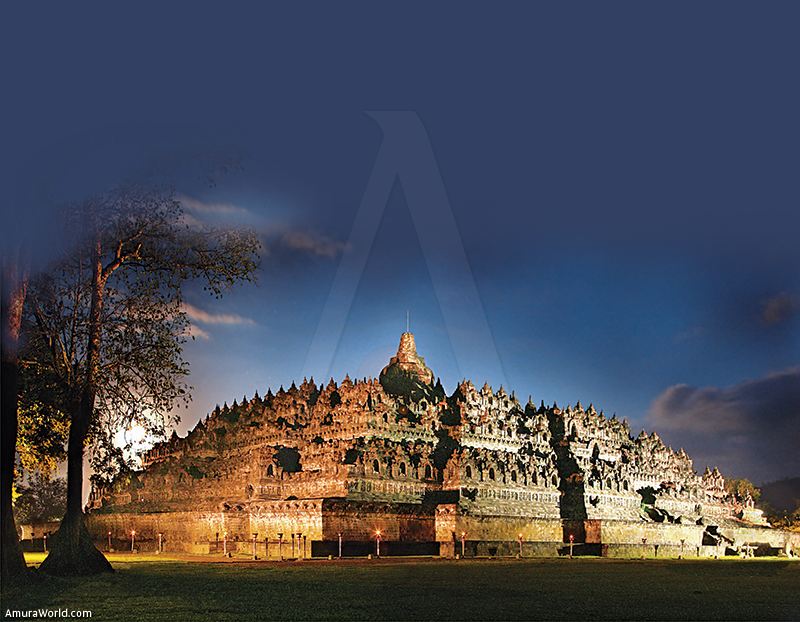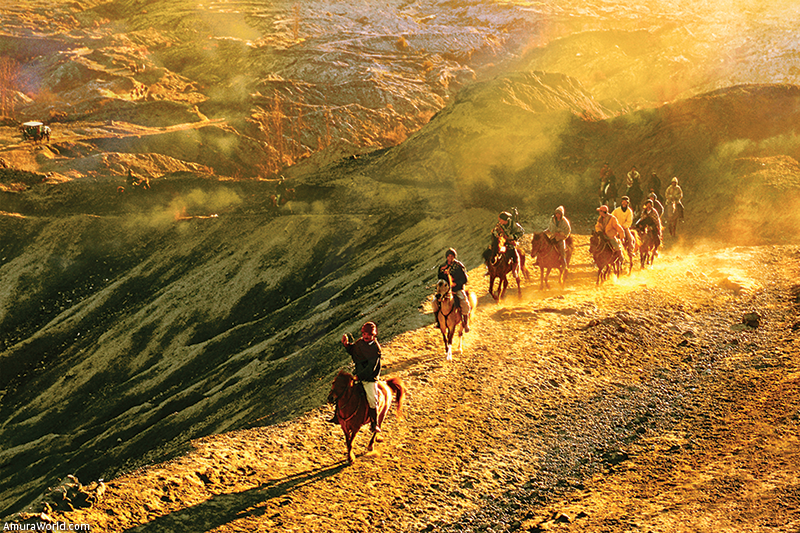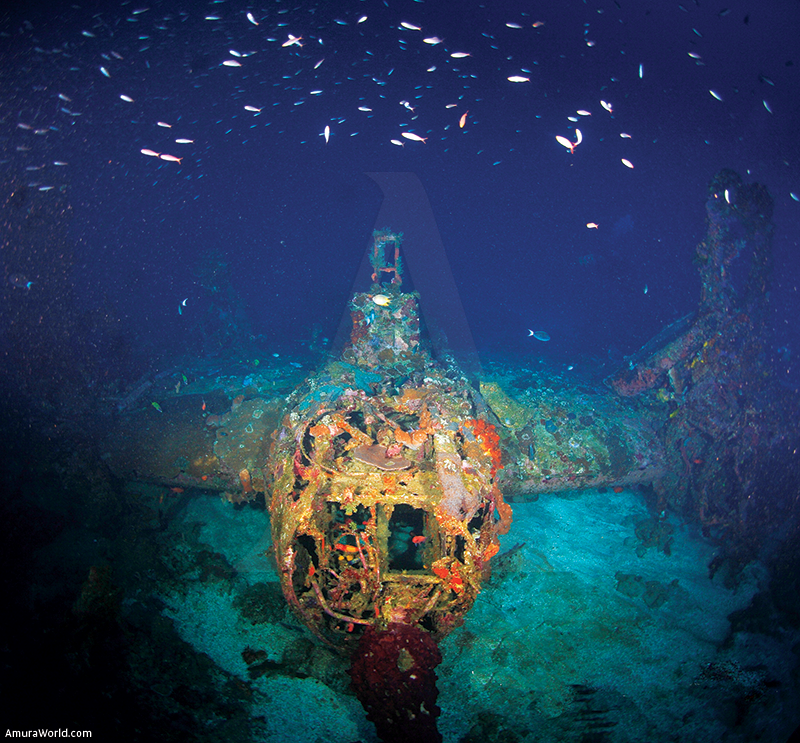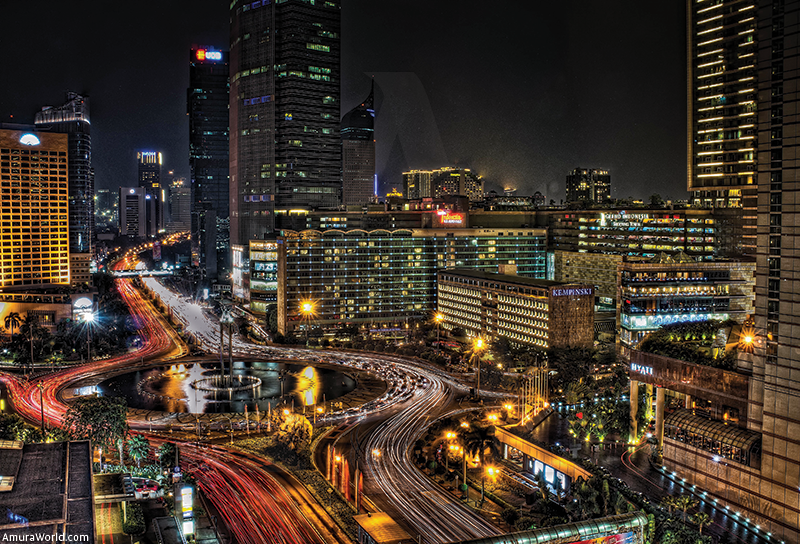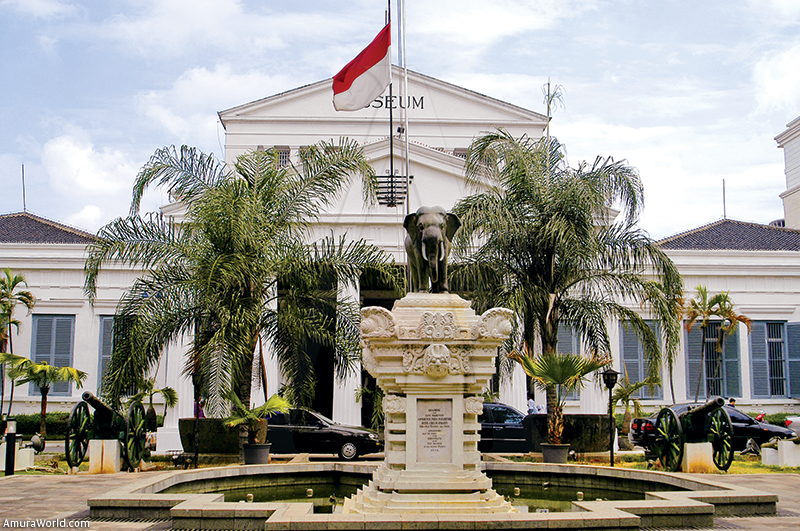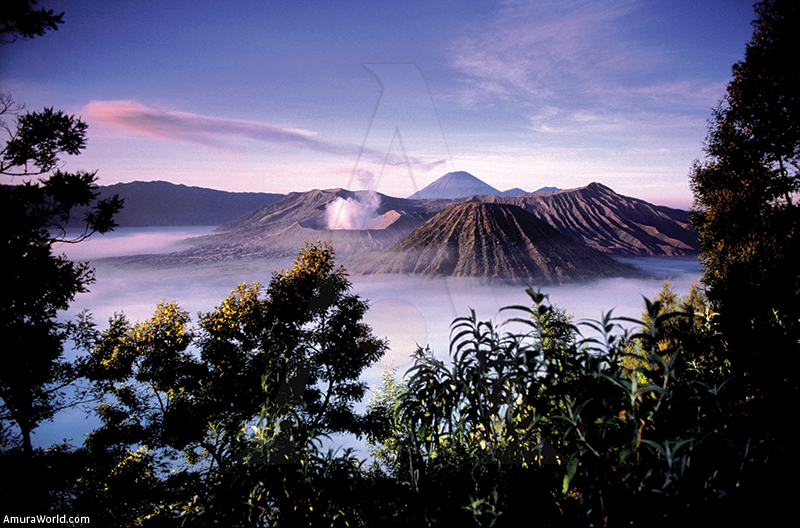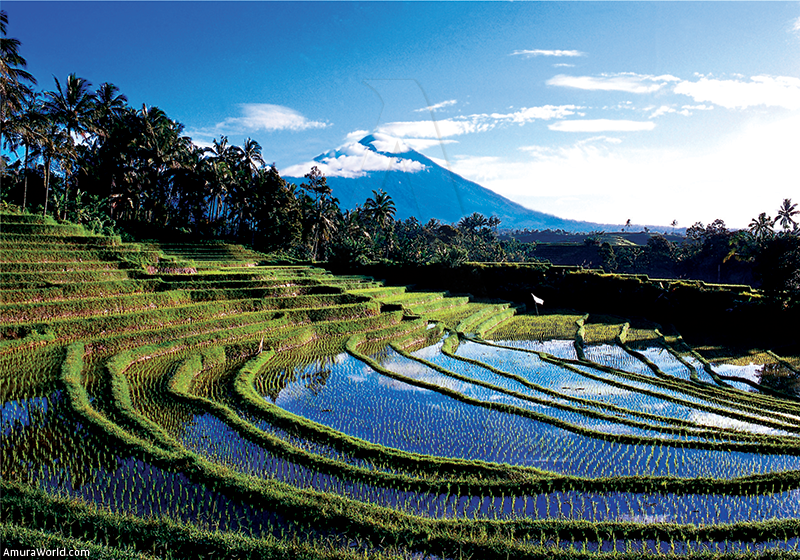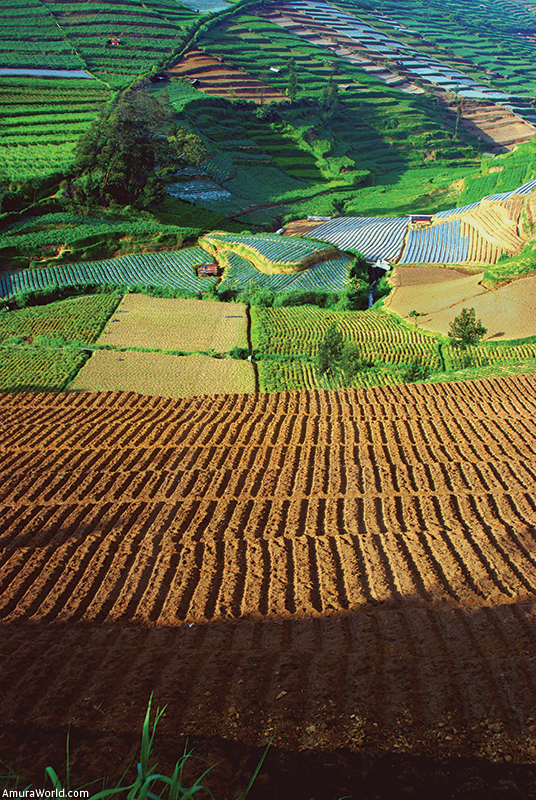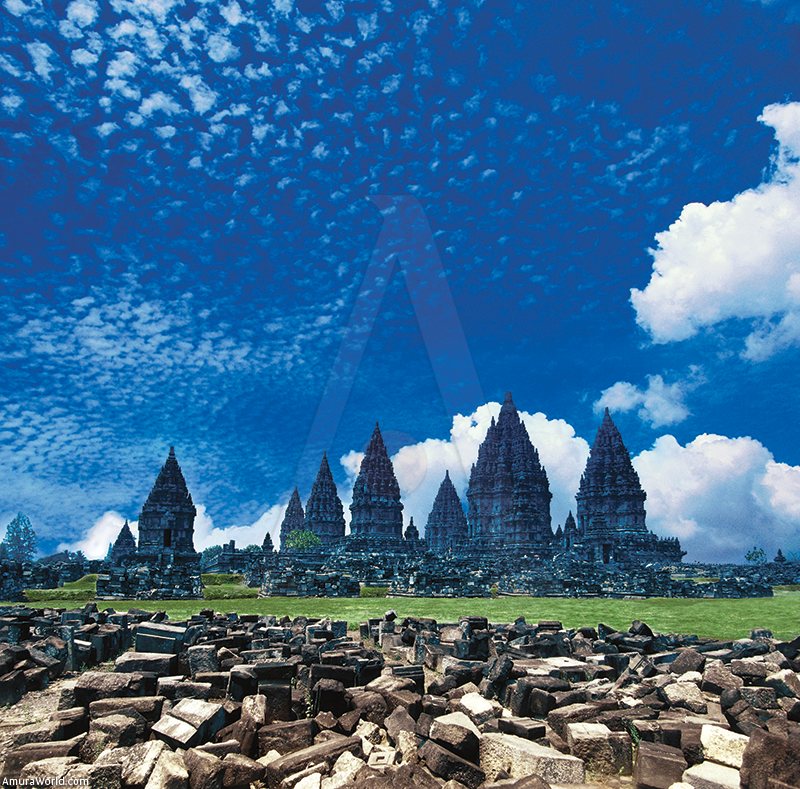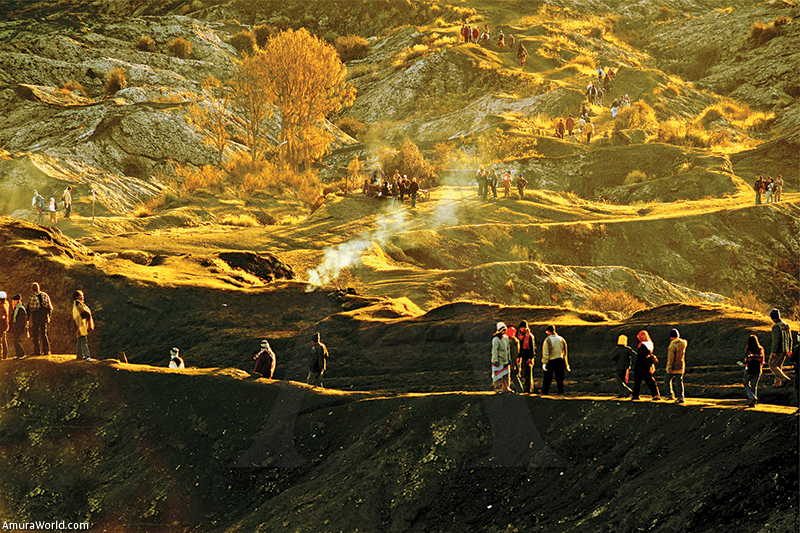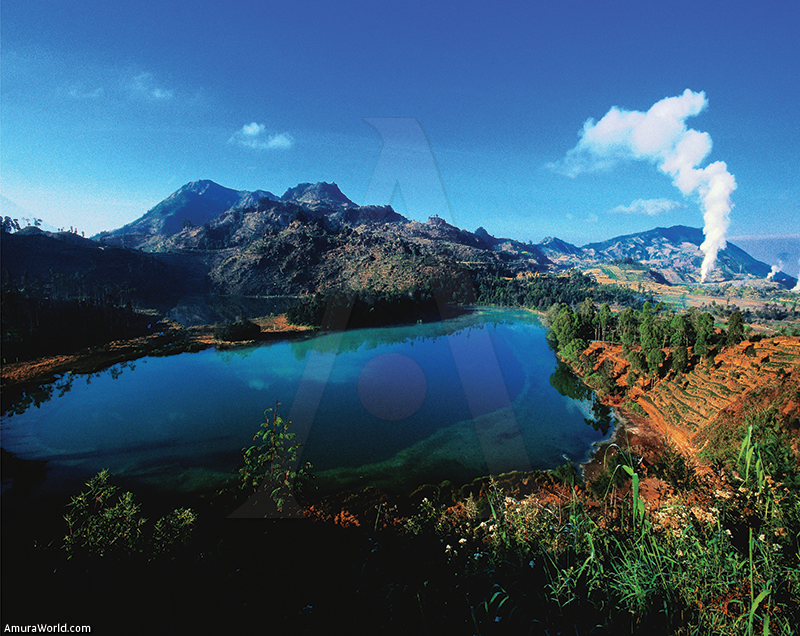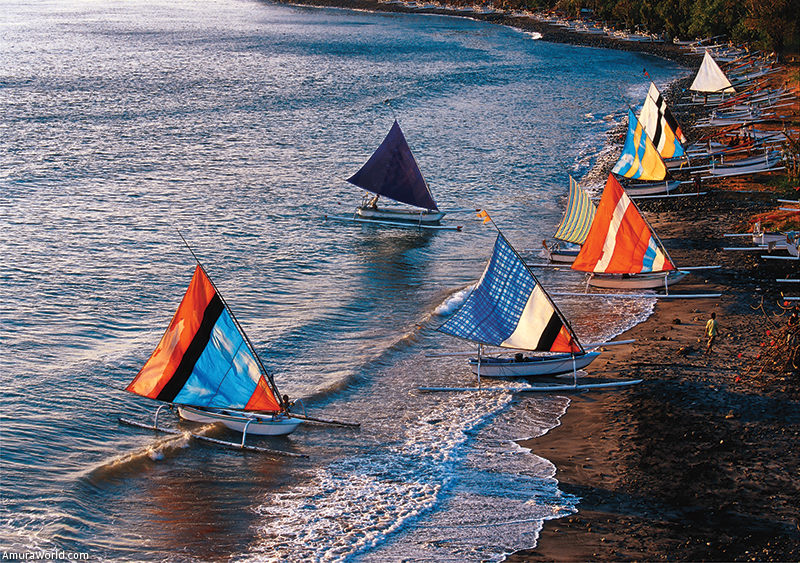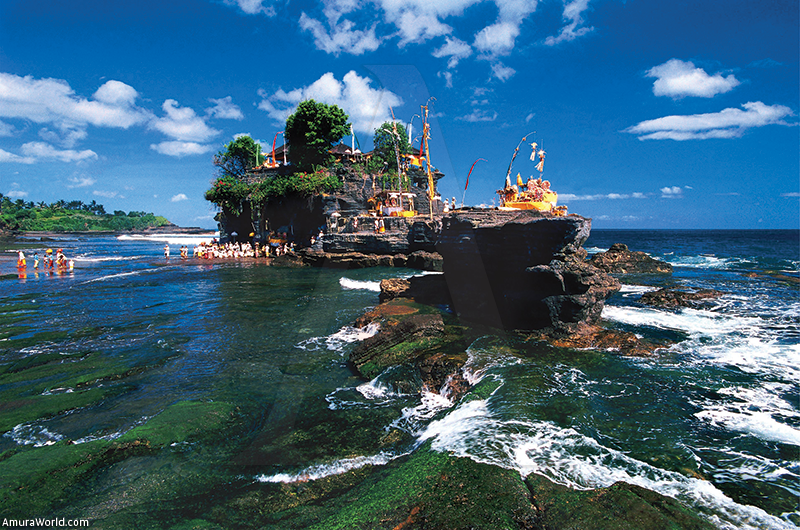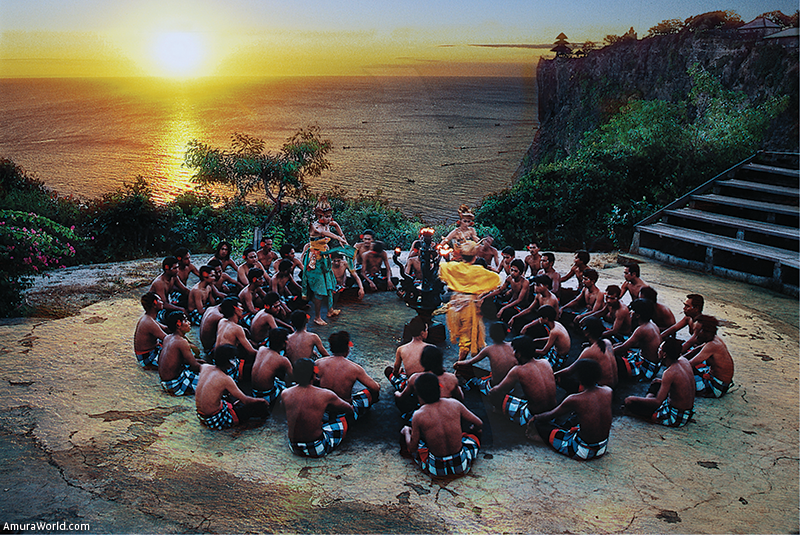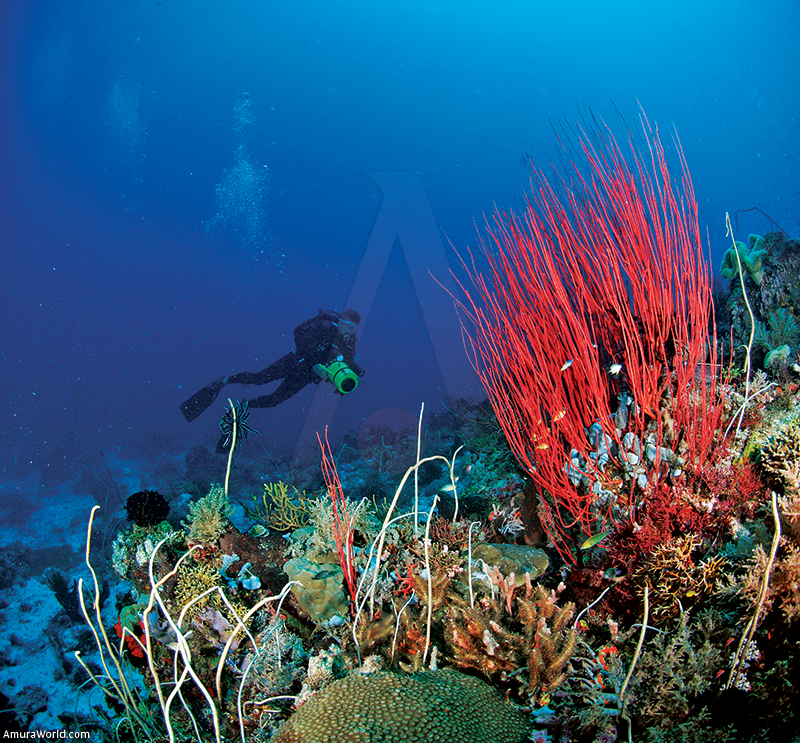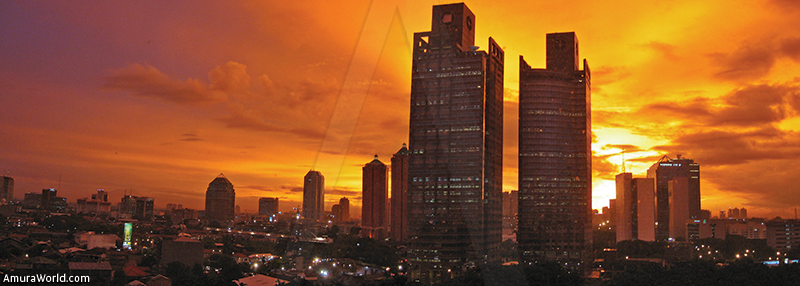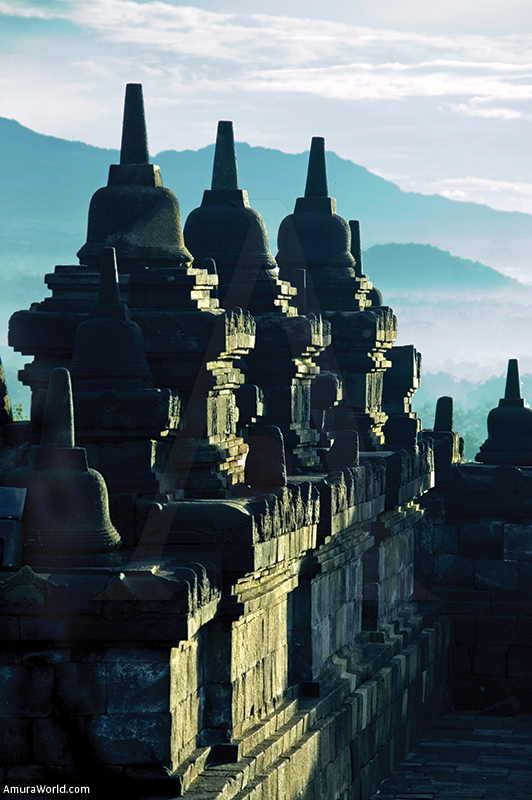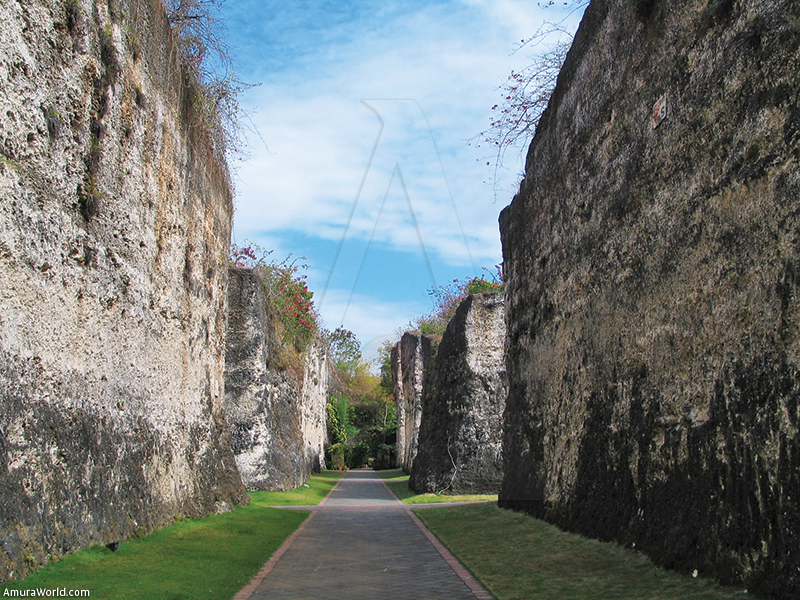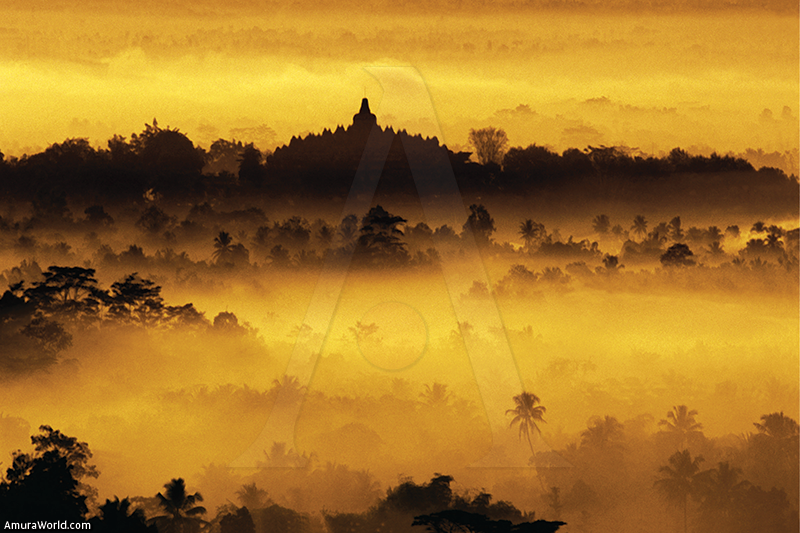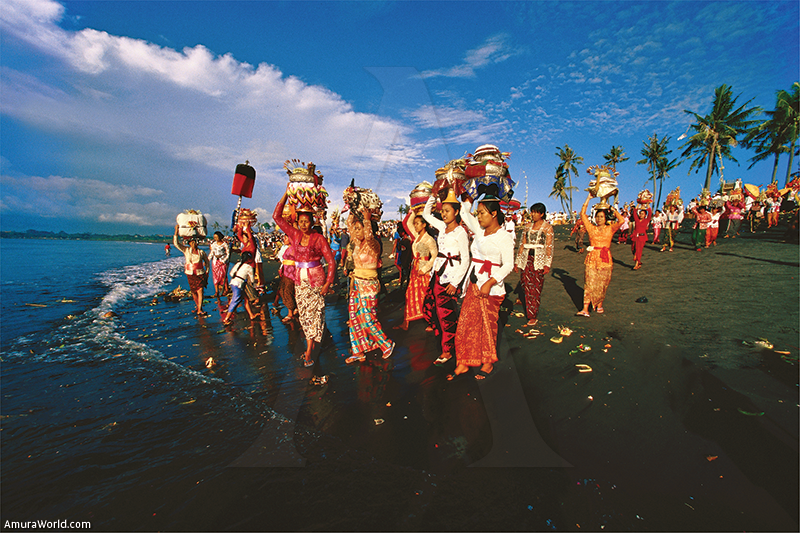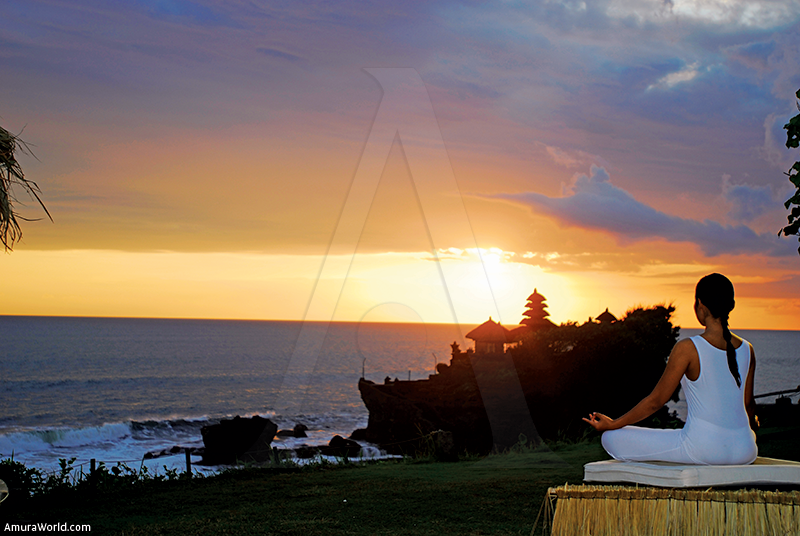{socialbuttons}
From island to island, Indonesia is a real shock of different cultures and landscapes, a journey that seduces you with its variety and originality. Although we made several trips to this vast country in the past, an archipelago of 17 400 islands, we decided to browse some points of interest such as Irian Jaya, Flores, Komodo, Lombok, Bali and Sulawesi, Borneo and Jakarta.
Irian Jaya-Papúa
We landed in Jayapura on the north coast of Irian Jaya, the easternmost part of Indonesia, where our yacht was expecting us. After visiting the port, we found Tanjung Ria beach, near the Hamadi market, where the Allied invasion took place on April 22, 1944, and ended the day eating delicious lobsters. We take the plane that dropped us off at Wamena in the middle of the Baliem valley heart, more than 1800 m surrounded by mountains over 4500 meters. We landed in the middle of town and while getting off the plane we were surprised with the Papuans almost naked in the streets. Men are dressed only with a different size pumpkin called Koteka, detained by a thread, and women have only a grass skirt and a bag or Noken hanging on his back. The main ethnic group is made up of Dani, but we also found Yali and Lani, all with dark skin and curly hair. Their first contact with white men goes back to 1938 when the pilot Richard Archbold, flying over the valley where the river ran Baliem, an uninhabited area in question, he noticed some fields and first discovered the Dani. It was not until 1954 that the first missionary, Lloyd Van Stone was dropped by parachute and the white man began to colonize the area. An airport was built although the road from Jayapura is not finished.
When discovered, the Dani were cannibals, and even today women are still the custom of cutting a phalanx when a relative dies in the family, so it is common to see women with all fingers cut off, except the thumb is always conserved. Widows are one time the head of the deceased husband in his noken and smeared her face with a white ground. The famous and admired men have been mummified with smoke and some mummies can be visited in some villages as Akima and Jiwika.
Passing the first culture clash, we realized that too many of the people were dressed. Then we walked dazed through the streets to the hotel, discovering an unusual world. Some men wore boar tusks inserted into the nose, which gave them a menacing air. We visited the market where we saw all sizes of pumpkin-koteka of faces, noken, people greet their friends holding her head, sit and talk, buy the essentials and we found out that pork and yams are the basis of their food.
We jumped on the only road that winds through the valley following the river that becomes the end of the pass rush to move down into the jungle. We visited a village where the houses are typical of straw round and the village is surrounded by a wooden fence. We received the head with his acolytes and put on their feather ornaments to take a picture with their bows and arrows. The boss was impressed because I had a scar larger than yours and we became close friends, despite the strong odor emanating from his body. On the other trail walk 3 hours watching the villages, spending a few rivers in precarious wooden bridges, and we reached a village where there was a party, danced with herbs that had to cover the oven carved into the earth where hot stones were placed on which placed the pigs and sealed the hole with grass. Women watched the chef work of men, many were missing several phalanges, some lice drew the other, some children wore the school uniform, a sign of the decadence of their dress so fascinating.
Before taking the plane back, we visited the mummy of an important ancestor, revered and cared for by the village chief, and left Wamena sadly sure that this enclave emerged from the Stone Age was in danger of disappearing, if propelled into the twenty-first century. The computer and karaoke made their appearance in society that emerged from the stone age.
Biak
We left the port of Jayapura in westerly direction, crossing several islands along the coast of Papua, to reach the island of Biak in Cenderawasih Bay in the middle of the archipelago of atolls, reefs and corals. Kota Biak is the port and the capital city of the island where the Melanesian population has dark skin and curly hair too, being another branch of Papuans. The beaches uncover their coral at low tide and visit the villages hidden in the rainforest, a cave that served as a hiding place for the Japanese in World War II because they had installed an important base in Biak, which was the origin of the battle of the same name when the United States took over the island. We visited the botanical garden where we saw a wide variety of orchids in the region, strange and colorful, and the small zoo find the legendary bird of paradise whose sumptuous long tail was used to adorn women’s hats at the beginning of the twentieth century. A huge snake would attack his caregiver while he was carrying it, and we were surprised by the wide range of fascinating colors parrots live from red to blue. A group of young people presented us with traditional dancing, Yosim Pancar, accompanied by the music of a type of ukulele.
We navigated between the atolls and stopped at an island of white sand where some fishermen living offered coconuts to freshen up. The sea was calm and warm, turquoise blue, people were smiling, coconut palms offered shade to escape the heat that swept the sea breeze, the island tasted to paradise. Navigating between the atolls we discovered many shipwrecks dating from the war and dive near one of them, around a magnificent coral reef to discover a huge variety of fish of all colors created an underwater paradise.
Flores y Komodo
Navegamos 3 días corridos, pasamos la gran península de Irian Jaya Barat,
We navigated 3 consecutive days and passed the great peninsula of Irian Jaya Barat, follow the strait between the islands in front of the Kota Sorong to enter the sea of the Moluccas. We stopped at the island of Maluku to enjoy the beautiful beaches and visit the fishing villages and boats kemari where floats adorned with beaches or rowed on the calm sea. We rested a moment on the fabulous beach of Hunimua in Ambon, with its white sand and clear sea of turquoise, and Aboru Bay with its jungle-covered cliffs that plunge into the sea. Finally we reached the western part of the large island of Flores where most people are Christian home where volcanoes and stunning lakes. We docked at the small port of Labuan Bajo, at the foot of jungle-covered hills overlooking a bay dotted with islands. White sand beaches and emerald sea we were invited to enjoy the tropical heat as the sunset painted the sky red and orange that turned purple. It was a fabulous evening, we tasted a lobster in a restaurant near the pier, the atmosphere is saturated with moisture, a lightning fell in the distance.
Early set sail for the Flores Sea, navegating between islands and peninsulas to reach the island of Komodo national park. We anchored in the beautiful bay where the sea licked jade white sand beaches at the foot of barren hills and yellow. After registering at the park entrance, we had our first meeting soon with the famous dragon, the largest monitor lizard and ferocious the world that can reach 2 to 3 meters long and weigh 70 kg. He was in his own habitat, the island has been preserved. It is an extremely dangerous carnivorous reptile that attacks with its powerful tail, or bite their prey to death, and their saliva contains many bacteria that if the animal is not dead, will die from infection and then the dragon will devour him. They also eat carrion. Some specimens were found near the house and the caretaker threw a cock that didn´t have time to react when it was in the dragon’s mouth, singing its last song. We were led the island, protected by a guardian, and we observed orchids, wild parrots and cockatoos, then we locked ourselves in a small enclosed balcony where we could see a lot of dragons. In that place, goats are usually thrown two times a week and so the dragons are gathered here. They looked amazing, looked at us with much desire to eat, their tails seemed deadly weapons, their mouths were like grinders with more than 60 teeth and drew his long yellow tongue. We scared when one of them moved, because it only sticks and guards protecting us had no guns.
Back at Timor we watched some deer, the dragon’s favorite food, as well as the boar, and wanted to get to the beach to swim and cool off. We found a dragon wandering there, one of which was swimming, which convinced us to not throw us away and sailed for that wonderful sanctuary where lives one of the world’s most dangerous animal that has devoured several men.
Lombok
We sailed through the sea of flowers that is a little more secure and we passed the big island of Nusa Tenggara with very deforested barren mountains, to meet the northern part of the island of Lombok where you can admire the jungle-covered volcanoes and we anchored in Medana the small bay, facing the sumptuous Oberoi hotel where we stayed in one of the wonderful villas with private pool and enjoy the excellent cuisine. 3 days rest in the luxury to let us agree, enjoying the sights, beaches and diving on the nearby islands. We visited some parts of the Muslim island of Lombok with its potteries, weavers and painters, with their villages hidden among the rice fields. Resuming our voyage we followed the coast of Lombok, admiring the beautiful white sand beaches protected bay surrounded by lush jungle-covered mountains.
Bali
Crossing the narrow, we reached the port of Benoa in Bali where we left the yacht for 6 days. Bali is enjoyed tasting the flavors of the dream island of the gods, a mixture of colors, music, dancing, creating fantasy landscapes perfect. Bali, the Hindu, is an oasis of peace and everlasting beauty, charm and magic surrounds us in the midst of tropical vegetation that blends the bright green rice fields populated with the temples of gods of stone covered with moss, with people and hot weather. Bali invites you to meditate and relax, taste, delight your eyes, mouth, ears, while the body vibes to the rhythm of nature’s lust.
Captain Cornelis de Houtman was the first European to reach the island in 1597 and returned to Holland with half of his men, since the other half never wanted to leave. Famous since the thirties by a group of artists, Bali is the treasure at the end of the rainbow, a magical tale with harmonious trails.
We settled first in the Four Seasons Jimbaran Bay hotel located on the beach with its sophisticated Balinese villas with pool staff and a superb view. The restaurants, spa and gardens create an idyllic nest immersed in a spiritual and mystical. Then we stayed at the Sayan, located in the middle of a canyon where the sacred Ayung River runs near Ubud, remarkable for its architecture. The entrance is through the roof where he designed a water lily pond, ideal for meditation at sunset, flying as if it was paradise. The villas with pool, spa, exotic cuisine, riverside pool are a decent set of house and wonderful gods to create an exotic and romantic.
As always, Bali greeted us warmly: Denpasar, the capital, has a very colorful market, Sanur, with a coral reef that protects it, is a pristine beach with calm waters. Kuta beach is the waves where surfers challenge the sea or where you can enjoy the massage. On the peninsula south of the island is Nusa Dua Beach, the most exclusive and spectacular with its clear waters. We visited the island by car and motorcycle, with the pleasure of discovering a harmonious world of nature, people, temples, towns and animals. In Sangeh we were received by the macaques, the kings of the jungle and took over the Pura Bukit Sari temple in the same way they took over a bag of peanuts or fruit. In Mengwi, formerly powerful kingdom of the dynasty Gelgel, we admired the temple of the deified ancestors, Pura Taman Ayun. Surrounded by a moat, is composed of several carved stone chapels that portrait gods, dragons, Garuda (bird god) and Hanuman (monkey god), with thatched roofs. People attend and brought bearing gifts of flowers and colorful fruits placed against the different altars. We arrived at Tanah Lot, the intriguing temple built on a small rock on the coast, accessible at low tide, adorned with beautiful temples island battered by the waves. We observe the pilgrimage, with men dressed in yellow walking over rocks to climb to the altar, carrying offerings and music. Dream place, when the sun went to bed, we admire the mystery that attaches to the rhythm of the sea, spectacular scenery unique in the world.
We walk around Ubud and Mas, the charming towns that captivate. But beyond being the Brahmins crib where it was established the first priest Danghyang Nirartha in the fifteenth century, we were surprised because it is the cradle of cabinetmakers. Ubud, the great art market, lives to the rhythm of the farmers who exhibit their fighting cocks and seduced us. The Mexican painter Covarrubias, eternal admirer of the island, said it was for the roosters to entertain people-watching. We walked through several villages that offer a cozy atmosphere because of the style of their houses made of red bricks, gray stone sculptures, which seem 2 tickets inviting pass hands together, covered with moss due to the heat and humidity constant. In Goa Gajah, the Elephant Cave, we admired the fantastic entrance carved into the rock that reproduces animals, leaves, waves and demons, including tiered rice fields. It was a great pleasure to ride a bicycle in the rice fields, waving to the peasants and reaching villages and temples decorated with flowers.
The road to the volcano was like a path to paradise, surrounded by forest with blooming orchids, coconut palms, rice terraces where the water ran into irrigation canals that are bathed in the golden-skinned women and almond eyes. In Tampaksiring we visited the ancient sacred springs turquoise waters released from the mouths of the dragons of stone, surrounded by temples. At the top, we sat down to watch the lake which inhabits the Batur volcano crater of 1720 m. The clouds, blinded in the tops, made a dance among the trees and temples recalling the magic of dance. In Bangli we were impressed with the Goddess Kala Makara, with its imposing face and his outstretched hands, which holds the spirits to prevent passage. Each Balinese has to visit this temple at least once a year. The curves of the road led us to the slopes of the volcano Gunung Agung (the highest and holiest of the island, 3140 m) in a scene worthy of the gods with rice terraces, up to Besakih, the holiest of all temples, at an altitude of 900 m. It’s a group of 30 temples on terraces connected by stairways and doors that are open divine towers in the middle. A ceremony emboldens the temple and women would present their offerings with their hair adorned with flowers and lace blouses, while men, praying in the courtyards of the temples, wore scarves in black and white checkered waist. It was a feast of colors in the bright tropical afternoon that frightened the black clouds threatening. We ended our visit with Klungklung in the coastal plain, the ancient capital of the first kingdom of the island, where its courthouse is. As a small pyramid decorated with sculptures of stone and surrounded by water, is notable for its ceiling decorated with frescoes depicting heaven and hell Balinese style.
In Bali, every village has its club music and are dedicated to discovering the charm of the different dances accompanied by the Gamelan: The Barong with his beautiful dancers surrounded by dragons and monsters, the Lelong with their golden dancers, the Baris that glorifies war, the Jauk Kebyar and the Janger that floats to the rhythm of the flute, Oleg Tambulilingan love duet with the legendary Ramayana tells the story of the Hindu epic. The Kecak dance is mesmerizing to the rhythm of the voices of 150 men, with different rhythms repeating the word “chak chak” to the dim light of the torch. The dances of Bali wrapped us in a vibrant pace mirage. Wayang Kulit (shadow theater) is the other essential dramatic world, an ancient art in which the leather puppets act against the light to tell the Mahabharata.
Bali is a set of so much beauty, from nature to their music and dance is the island dreamed by the Hindu gods that comes true for the pleasure of man.
Sulawesi
It was very difficult for us to leave that paradise, that peculiar nirvana of the two Seasons hotels, and the fascinating world of Bali, but we embarked with a taste of adventure, knowing that we would discover a new world* (discover new horizons*) in the next island. Heading north, we crossed the China sea to reach the misterious Sulawesi, also known as the Celebes Island. We stopped shortly on Ujungpandang, the lively capital, to continue sailing to the north and we left the yacht anchored in the narrow bay of Bacukiki, where the 4x4 vehicle was waiting to take us to the fabulous land of the Toraja. We crossed the heels and cliffs, adorned with sumptuous green rice fields where the vegetation was mirrored on the water. The jungle framed that landscape that looked like a Naïve painting, and finally we entered Tana Toraja, the Toraja region, marked with a door shaped like gabled roof houses.
Most of the population is Christian, with peculiar rites called Aluk To Dolo (Ancestors’ Tradition). The funerary rites* (ceremonies) are elaborated and complicated; they bury people in caves in cliffs, placing dressed wooden figures that represent them. Their houses, named Tongkonan, impress with their high slope with decorated panels. It is a beautiful, green region that offers the pleasure of watching people and their customs. We settled in a charming hotel very close of Rantepao, where the orchids adorned the garden and the jungle embraced that little paradise. From there we visited the towns of Makale, Sangalla, Sangalangi and Wara Utara. We also went to one of the cemetery-cliffs of Pala’Toke’, where the huge precipice holds the ancestors’ burials. There are some balconies in the rock, from which some figures representing the dead can be seen. These wooden statuettes are called Tau Tau, they have their looks pointing to the rice fields and people often change their clothes. It impressed us greatly to see those figures looking at us as if they were ghosts from the past. We also visited Lemo’s site, which is very similar with some impressive* (imposing) ancestors galleries.
We stopped at a small town and we were invited to a funeral ceremony. People were installed in small houses with balconies facing to a square of earth, where 5 buffaloes were sacrificed before we arrived. They ripped off their skin and they were dividing the meat. An orchestra was playing, the family of the deceased was installed on the most decorated balcony and the recently arrived guests greeted them. The coffin was near them, and surely it contained a very important figure of the town, because of the size of the ritual and the number of sacrificed buffaloes. Some pigs were screaming, ready to be offered too. The union of the ceremony with all the details impressed us, and we left the place with the feeling of having been in another planet, in an unknown and intriguing world.
Water buffaloes are sacred, and the wealth of the families is shown by how many they own. We saw the children looking after them next to the rice fields, often mounted on their backs, while some grandparents fished on holes deliberately left in the middle of the paddies. The landscape was beautiful and we visited many towns of long houses with curved roofs and prominent peaks that reminded of an upside down boat. Houses or Tongkonan were lined to create a central street and the barns stood between them. The wooden walls were elegantly decorated, carved and painted in red, black and yellow, which gave much beauty to the villages.
Near a town, we visited the cliff next to where the coffins were placed alongside a path going up. Many of them were open and the bones were respectfully exposed. The wood was sculpted with elegance. The ones hanging from the cliff contained children bodies, and one of them had a privileged space under a roof. It belonged to someone very important. That open cemetery was a macabre and fascinating place.
After visiting the villages, the rice fields and cliffs, the rivers and waterfalls that ran through that beautiful scenery, we left Tana Toraja with the taste of having entered a preserved world, rich with ancestral traditions and the wish of letting the doors closed so it could be preserved as it is. We returned to the shore to get on our yacht and continue sailing.
Borneo
We crossed the Strait of Makassar and reached the port of Kota Balikpapan, at the Indonesian part of the Borneo Island that shined with the sunlight that illuminated the shore. After getting fuel and food, we continued along the jungle and white sand beaches that covered the seaboard until we arrived to Kumai, a small village near Pangkalan Bun, where we rented a local boat named Klotok, that is 12 m long, to enter the river. On its bank we could see palms growing and some monkeys that inhabited the highest tree branches. Finally, we arrived to the Lodge where we stayed, surrounded by the apes that ran throughout the hotel. The next day we went into Tanjung Puting national park and discovered Leakey Camp, where the orangutans are reintegrated to the jungle. Here, Dr. Birute Galdikas has studied orangutans’ behavior for decades. We had some very interesting encounters with those big apes, and one of them, whom people called The Boss, was huge and menacing though he seemed to be quiet, but no one came near him. He was attracted to a female, so he hugged her and she let him want her with a sweet look on her face.
We strolled through the jungle, meeting orangutans of different ages and various attitudes. Some were timid, others climbed on us, some others held hands with us to walk. A mother took the toothbrush of one of our fellows and brushed his son’s teeth, imitating a person. In the jungle, men gave fruits to them and more than 10 apes appeared. It was an impressive scene to see those semi-wild animals, so similar to men, in their natural environment. Most of them had been pet to man and were reintegrated to wildlife. Some of them had friends from the jungle and others were completely wild, with no fear for men. We were amazed with those fabulous encounters, watching the gibbons and proboscis monkeys, wild boars, nature, orchids, butterflies and birds like hornbills and kingfishers, trees and above all, the orangutans.
We sailed upstream with the klotok to visit a town built by man to look for gold. The jungle was cut down to search for the precious metal in the remaining sand. Nothing grew anymore on that poor soil, the heat was unbearable, the wooden cottages were the only providers of shade and people lived in that unhealthy place, filtering sand with sieves in search of the valuable dust, risking their health and their life in that hell.
We returned to the Lodge to enjoy the sunset, watching the apes running by the wooden scaffolding or ceilings, and also enjoyed the evening with young people who improvised a concert of local and international music. The next day, sailing through the river, we watched more orangutans and arrived to our yacht.
Jakarta
Finally we crossed Java Sea to arrive to Jakarta, the great capital city with a Dutch-colony flavored neighborhood, where we left the yacht in the navy. We enjoyed the pubs and restaurants, the city modern life with its shopping and turmoil. Jakarta absorbed us with its bars and the great mosque, the malls and the gardens.
The trip was over and we had our minds full with sumptuous images tied to memories worth of Indiana Jones adventures. Indonesia, as always, amazed, fascinated and charmed us and left us with an eagerness to return with more time and to meet more extraordinary people. We kept on dreaming about Bali people, or the Toraja, with the Papuans or the Komodo dragon, with orangutans and white sand beaches. Indonesia is an authentic exotic adventure book, with a taste of tropical heat and delicate fruit amid the perfumes of the jungle.
Text: XX ± Photo: Patrick Monney , Embajada de Indonesia

